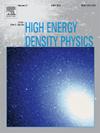NN-PTS: a neural network-assisted PAPR reduction technique for OTFS with high-order modulation
IF 0.9
3区 物理与天体物理
Q3 PHYSICS, FLUIDS & PLASMAS
引用次数: 0
Abstract
This paper introduces a new neural network-based partial transmit sequence (NN-PTS) approach for peak-to-average power ratio (PAPR) reduction in orthogonal time frequency space (OTFS) modulation, assessed over various modulation schemes—512-QAM, 256-QAM, and 64-QAM. The new method overcomes the PAPR and bit error rate (BER) trade-off associated with the traditional approaches. For 512-QAM, NN-PTS has an outstanding PAPR reduction to 4.8 dB at a CCDF of 10⁻⁴, surpassing traditional approaches like Selected Mapping (SLM)+PTS (8 dB), PTS (9.9 dB), and others. Likewise, for 256-QAM and 64-QAM, NN-PTS has minimum PAPR values of 3.7 dB and 1.8 dB, respectively, while having significant gains of 2.7 dB to 4.7 dB and 3.4 dB to12 dB over other techniques. In addition, BER analysis also substantiates that NN-PTS reduces PAPR while exhibiting poor BER performance. To illustrate, under 512-QAM at BER = 10⁻⁵, only 10 dB SNR is needed for NN-PTS, while it has a maximum 13 dB gain over the original OTFS signal. A similar trend also occurs for 256-QAM, where the NN-PTS achieves up to a 10.1 dB improvement in SNR compared to the traditional schemes. The outcomes prove that the NN-PTS best trades off PAPR reduction and BER efficiency under changing modulation orders, adaptable to various fading conditions. This renders the proposed NN-PTS a promising candidate for next-generation and 5 G systems, where high spectral efficiency and resilient signal quality are essential.
NN-PTS:一种神经网络辅助的高阶调制OTFS PAPR降低技术
本文介绍了一种新的基于神经网络的部分传输序列(NN-PTS)方法,用于降低正交时频空间(OTFS)调制中的峰均功率比(PAPR),并对各种调制方案(512- qam, 256-QAM和64-QAM)进行了评估。该方法克服了传统方法所带来的PAPR和误码率的权衡问题。对于512-QAM, NN-PTS具有出色的PAPR降低到4.8 dB, CCDF为10⁻⁴,超过了传统的方法,如选择映射(SLM)+PTS (8 dB), PTS (9.9 dB)等。同样,对于256-QAM和64-QAM, NN-PTS的最小PAPR值分别为3.7 dB和1.8 dB,同时比其他技术具有2.7 dB至4.7 dB和3.4 dB至12 dB的显著增益。此外,误码率分析也证实了NN-PTS在表现出较差的误码率性能的同时降低了PAPR。举例来说,在BER = 10的512-QAM下,NN-PTS只需要10 dB的信噪比,而它比原始OTFS信号的增益最大为13 dB。类似的趋势也出现在256-QAM中,与传统方案相比,NN-PTS的信噪比提高了10.1 dB。结果表明,在改变调制阶数的情况下,NN-PTS能很好地平衡PAPR降低和BER效率,适应各种衰落条件。这使得所提出的NN-PTS成为下一代和5g系统的有希望的候选者,其中高频谱效率和弹性信号质量是必不可少的。
本文章由计算机程序翻译,如有差异,请以英文原文为准。
求助全文
约1分钟内获得全文
求助全文
来源期刊

High Energy Density Physics
PHYSICS, FLUIDS & PLASMAS-
CiteScore
4.20
自引率
6.20%
发文量
13
审稿时长
6-12 weeks
期刊介绍:
High Energy Density Physics is an international journal covering original experimental and related theoretical work studying the physics of matter and radiation under extreme conditions. ''High energy density'' is understood to be an energy density exceeding about 1011 J/m3. The editors and the publisher are committed to provide this fast-growing community with a dedicated high quality channel to distribute their original findings.
Papers suitable for publication in this journal cover topics in both the warm and hot dense matter regimes, such as laboratory studies relevant to non-LTE kinetics at extreme conditions, planetary interiors, astrophysical phenomena, inertial fusion and includes studies of, for example, material properties and both stable and unstable hydrodynamics. Developments in associated theoretical areas, for example the modelling of strongly coupled, partially degenerate and relativistic plasmas, are also covered.
 求助内容:
求助内容: 应助结果提醒方式:
应助结果提醒方式:


